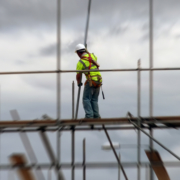Jason Schiciano Discusses the Scaffold Law on lohud.com
You may have read articles or seen local news reports in recent months concerning New York’s Scaffold Law. Levitt-Fuirst advocates on issues that affect its clients.
Jason Schiciano, Co-President of Levitt-Fuirst, is a recognized local leader in the fight to reform this law, and his most recent article on the subject is below. While the Scaffold Law drastically increases liability insurance costs for contractors, its secondary effects include:
- Higher construction costs for new homes;
- Higher liability insurance costs for commercial real estate owners, including apartments, office and industrial buildings;
- Higher residential apartment and commercial space rent rates;
- Higher taxes, due to higher costs to construct, renovate, and maintain public infrastructure, such as schools, municipal buildings, and bridges;
- Less tax revenue available to allocate to school renovations, new schools, and hiring teachers.
…So, one way or another, New York’s Scaffold Law hurts ALL of New York’s citizens.
____________________________________________________________
“Scaffold Law drives up cost of construction in New York, insurance broker says”
Jason Schiciano, Published 7:00 p.m. ET, Jan. 9, 2019
The following story can be found HEREon the lohud.com website.
“There is a crisis in the construction insurance market that is costing New Yorkers billions. Every home, every school, every bridge costs more because of this crisis. Gov. Andrew Cuomo and our elected officials in Albany could fix it with the stroke of a pen, but so far special interests – in particular, the trial lawyers’ lobby – have blocked efforts at reform.
The crisis is caused by the so-called “Scaffold Law,” an archaic construction liability law that only exists in New York. The law holds contractors and property owners 100 percent liable for
gravity-related construction jobsite injuries, even if they are as little as 1 percent at fault. Such a law runs counter to our most basic principles of justice.
gravity-related construction jobsite injuries, even if they are as little as 1 percent at fault. Such a law runs counter to our most basic principles of justice.
The following story can be found HEREon the lohud.com website.
“There is a crisis in the construction insurance market that is costing New Yorkers billions. Every home, every school, every bridge costs more because of this crisis. Gov. Andrew Cuomo and our elected officials in Albany could fix it with the stroke of a pen, but so far special interests – in particular, the trial lawyers’ lobby – have blocked efforts at reform.
The crisis is caused by the so-called “Scaffold Law,” an archaic construction liability law that only exists in New York. The law holds contractors and property owners 100 percent liable for
gravity-related construction jobsite injuries, even if they are as little as 1 percent at fault. Such a law runs counter to our most basic principles of justice.
gravity-related construction jobsite injuries, even if they are as little as 1 percent at fault. Such a law runs counter to our most basic principles of justice.
The effect of the Scaffold Law is that liability insurance prices for construction projects here in New York are dramatically higher than anywhere else in the county. Worse, with liability
untethered from actual fault, and potential million-dollar liability judgments, most insurers will not write policies for New York construction projects at all. I should know, I am an insurance
broker who struggles to find quality insurance at reasonable premiums for New York construction contractors. But because of the uncertainty caused by outdated Scaffold Law, there
are fewer and fewer options.
untethered from actual fault, and potential million-dollar liability judgments, most insurers will not write policies for New York construction projects at all. I should know, I am an insurance
broker who struggles to find quality insurance at reasonable premiums for New York construction contractors. But because of the uncertainty caused by outdated Scaffold Law, there
are fewer and fewer options.
Of the carriers that do write liability insurance for construction, most are “non-admitted,” meaning that their financial obligations (including claim payments) are not guaranteed by New York state in cases of carrier insolvency. These carriers’ policies often have exclusions that restrict or eliminate coverage for Scaffold Law claims.
If you don’t think you are paying for New York’s construction insurance crisis, think again. Every public project costs more due to the Scaffold Law. Estimates suggest the law added at
least an additional $200 million to the price of the new Gov. Mario M. Cuomo Bridge, which travelers might help fund through higher tolls.
least an additional $200 million to the price of the new Gov. Mario M. Cuomo Bridge, which travelers might help fund through higher tolls.
The negatives of this law even affect our children. For instance, the City of Yonkers School district has a $2 billion plan to rebuild its crumbling facilities. But the Scaffold Law will add up
to $114 million in additional costs to this badly needed project. That is money that becomes unavailable to build another school, refurbish existing classrooms or even hire more teachers.
to $114 million in additional costs to this badly needed project. That is money that becomes unavailable to build another school, refurbish existing classrooms or even hire more teachers.
The Scaffold Law is a liability law, not a safety law (as some claim). A Cornell study peer reviewed by the National Academies concludes that the law has no positive impact on job site safety. The proposed reform would not weaken any existing safety protections for workers; it would simply apportion liability based on fault, the same way it is done in every other state and
every other part of New York’s legal system. The proposed reform would only weaken personal injury trial lawyers’ ability to secure huge settlements and judgments when their clients are
primarily at fault for their own injuries.
every other part of New York’s legal system. The proposed reform would only weaken personal injury trial lawyers’ ability to secure huge settlements and judgments when their clients are
primarily at fault for their own injuries.
With the advent of Workers Compensation insurance, all other states in the union have reformed absolute liability or gravity-related construction injuries to a standard of comparative
negligence. Cuomo and the state Legislature can do the same in New York. Our state government needs to stand up to the special interests in Albany and fight for a more just Scaffold
Law. By simply reforming our law, similar to other states, we can restore stability to our
construction insurance market, create jobs, and save billions in taxpayer dollars.
negligence. Cuomo and the state Legislature can do the same in New York. Our state government needs to stand up to the special interests in Albany and fight for a more just Scaffold
Law. By simply reforming our law, similar to other states, we can restore stability to our
construction insurance market, create jobs, and save billions in taxpayer dollars.
The writer is co-president of Tarrytown-based Levitt-Fuirst Insurance. Jason Schiciano”
The effect of the Scaffold Law is that liability insurance prices for construction projects here in New York are dramatically higher than anywhere else in the county. Worse, with liability
untethered from actual fault, and potential million-dollar liability judgments, most insurers will not write policies for New York construction projects at all. I should know, I am an insurance
broker who struggles to find quality insurance at reasonable premiums for New York construction contractors. But because of the uncertainty caused by outdated Scaffold Law, there
are fewer and fewer options.
untethered from actual fault, and potential million-dollar liability judgments, most insurers will not write policies for New York construction projects at all. I should know, I am an insurance
broker who struggles to find quality insurance at reasonable premiums for New York construction contractors. But because of the uncertainty caused by outdated Scaffold Law, there
are fewer and fewer options.
Of the carriers that do write liability insurance for construction, most are “non-admitted,” meaning that their financial obligations (including claim payments) are not guaranteed by New York state in cases of carrier insolvency. These carriers’ policies often have exclusions that restrict or eliminate coverage for Scaffold Law claims.
If you don’t think you are paying for New York’s construction insurance crisis, think again. Every public project costs more due to the Scaffold Law. Estimates suggest the law added at
least an additional $200 million to the price of the new Gov. Mario M. Cuomo Bridge, which travelers might help fund through higher tolls.
least an additional $200 million to the price of the new Gov. Mario M. Cuomo Bridge, which travelers might help fund through higher tolls.
The negatives of this law even affect our children. For instance, the City of Yonkers School district has a $2 billion plan to rebuild its crumbling facilities. But the Scaffold Law will add up
to $114 million in additional costs to this badly needed project. That is money that becomes unavailable to build another school, refurbish existing classrooms or even hire more teachers.
to $114 million in additional costs to this badly needed project. That is money that becomes unavailable to build another school, refurbish existing classrooms or even hire more teachers.
The Scaffold Law is a liability law, not a safety law (as some claim). A Cornell study peer reviewed by the National Academies concludes that the law has no positive impact on job site safety. The proposed reform would not weaken any existing safety protections for workers; it would simply apportion liability based on fault, the same way it is done in every other state and
every other part of New York’s legal system. The proposed reform would only weaken personal injury trial lawyers’ ability to secure huge settlements and judgments when their clients are
primarily at fault for their own injuries.
every other part of New York’s legal system. The proposed reform would only weaken personal injury trial lawyers’ ability to secure huge settlements and judgments when their clients are
primarily at fault for their own injuries.
With the advent of Workers Compensation insurance, all other states in the union have reformed absolute liability or gravity-related construction injuries to a standard of comparative
negligence. Cuomo and the state Legislature can do the same in New York. Our state government needs to stand up to the special interests in Albany and fight for a more just Scaffold
Law. By simply reforming our law, similar to other states, we can restore stability to our
construction insurance market, create jobs, and save billions in taxpayer dollars.
negligence. Cuomo and the state Legislature can do the same in New York. Our state government needs to stand up to the special interests in Albany and fight for a more just Scaffold
Law. By simply reforming our law, similar to other states, we can restore stability to our
construction insurance market, create jobs, and save billions in taxpayer dollars.
The writer is co-president of Tarrytown-based Levitt-Fuirst Insurance. Jason Schiciano”



